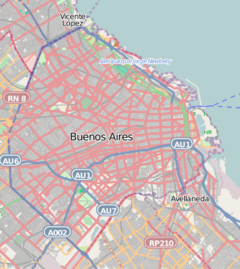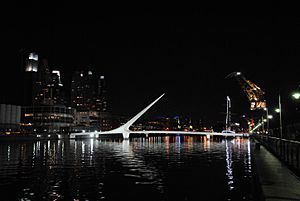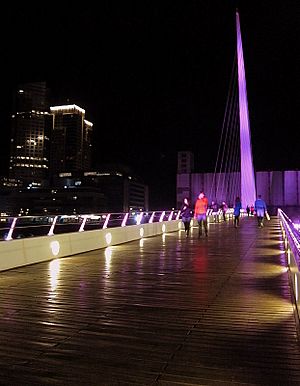Puente de la Mujer facts for kids
Quick facts for kids Woman's BridgePuente de la Mujer |
|
|---|---|

|
|
| Crosses | Dock 3 in Puerto Madero |
| Locale | Buenos Aires, Argentina |
| Characteristics | |
| Design | Forward cantilever with gate-swing opening |
| Material | Steel, reinforced concrete |
| Total length | 170 metres |
| Width | 6.20 metres |
| Height | 34 metres |
| Longest span | 102.5 metres |
| History | |
| Designer | Santiago Calatrava |
| Construction begin | 1998 |
| Opened | 20 December 2001 |
| Statistics | |
| Daily traffic | pedestrian |
The Puente de la Mujer is a famous bridge in Buenos Aires, Argentina. Its name means "Woman's Bridge" in Spanish. This special bridge is for people to walk across. It connects parts of the Puerto Madero area.
What makes it unique is that it can rotate! This allows boats to pass through the water below. The bridge has one tall mast and strong cables. A part of the bridge swings 90 degrees to open up. When it opens, one end rests on a special support.
How the Bridge Was Designed
A famous Spanish architect named Santiago Calatrava designed this bridge. He also designed similar bridges in Spain and California. The Puente de la Mujer was the first of only two bridges Calatrava built in Latin America.
Calatrava said the bridge's design looks like a couple dancing the tango. The bridge is 170 meters (about 558 feet) long. It weighs 800 tonnes, which is like 800 small cars! The bridge is 6.20 meters (about 20 feet) wide.
The bridge has two fixed parts and a middle section. This middle part is 102.5 meters long. It rotates on a white concrete pylon. This rotation lets boats pass in less than two minutes. A tall steel "needle" supports the central part. This "needle" is about 34 meters (112 feet) high. It holds the bridge up with strong suspension cables. A computer system controls the turning of the bridge.
Many streets in the Puerto Madero area are named after women. This is why the bridge is called the "Woman's Bridge."
History of the Bridge
A businessman named Alberto L. González thought of the idea for the bridge. He also gave money to help build it. The bridge cost about US$6 million. It was made in Spain by a company called Urssa.
The bridge was not originally part of the Puerto Madero plan. An advertising expert suggested building a landmark bridge. He thought it would be more useful than just an advertising campaign. The developer agreed with this idea.
Construction of the Puente de la Mujer began in 1998. It officially opened on December 20, 2001. In 2018, the bridge was recognized as a Cultural Heritage site of Buenos Aires. In 2022, the bridge's floor was updated. They used "plastic wood" made from recycled bottles.
See also
 In Spanish: Puente de la Mujer para niños
In Spanish: Puente de la Mujer para niños
- Sundial Bridge, Redding, United States
- Puente de la Unidad, Monterrey, Mexico
- Samuel Beckett Bridge, Dublin, Ireland
- Alamillo Bridge, Seville, Spain
- Chords Bridge, Jerusalem, Israel





